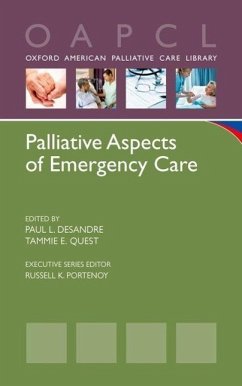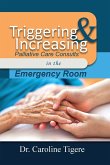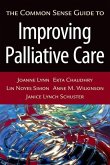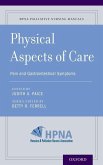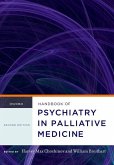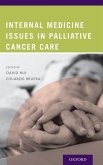Palliative Aspects of Emergency Care
Herausgeber: Desandre, Paul L.; Quest, Tammie E.
Palliative Aspects of Emergency Care
Herausgeber: Desandre, Paul L.; Quest, Tammie E.
- Broschiertes Buch
- Merkliste
- Auf die Merkliste
- Bewerten Bewerten
- Teilen
- Produkt teilen
- Produkterinnerung
- Produkterinnerung
Palliative Care in the Emergency Care is a practical guide for the care of patients with advanced illness who present to the emergency department.
Andere Kunden interessierten sich auch für
![Triggering and Increasing Palliative Care Consults in the Emergency Room Triggering and Increasing Palliative Care Consults in the Emergency Room]() Caroline TigereTriggering and Increasing Palliative Care Consults in the Emergency Room23,99 €
Caroline TigereTriggering and Increasing Palliative Care Consults in the Emergency Room23,99 €![The Common Sense Guide to Improving Palliative Care The Common Sense Guide to Improving Palliative Care]() Joanne LynnThe Common Sense Guide to Improving Palliative Care53,99 €
Joanne LynnThe Common Sense Guide to Improving Palliative Care53,99 €![Physical Aspects of Care Physical Aspects of Care]() Physical Aspects of Care48,99 €
Physical Aspects of Care48,99 €![Handbook of Psychiatry in Palliative Medicine Handbook of Psychiatry in Palliative Medicine]() Handbook of Psychiatry in Palliative Medicine114,99 €
Handbook of Psychiatry in Palliative Medicine114,99 €![Medicine and Care of the Dying Medicine and Care of the Dying]() Milton LewisMedicine and Care of the Dying68,99 €
Milton LewisMedicine and Care of the Dying68,99 €![Internal Medicine Issues in Palliative Cancer Care Internal Medicine Issues in Palliative Cancer Care]() David HuiInternal Medicine Issues in Palliative Cancer Care75,99 €
David HuiInternal Medicine Issues in Palliative Cancer Care75,99 €![Communication in Palliative Care Communication in Palliative Care]() Janet DunphyCommunication in Palliative Care122,99 €
Janet DunphyCommunication in Palliative Care122,99 €-
-
-
Palliative Care in the Emergency Care is a practical guide for the care of patients with advanced illness who present to the emergency department.
Produktdetails
- Produktdetails
- Verlag: Oxford University Press
- Seitenzahl: 154
- Erscheinungstermin: 1. Mai 2013
- Englisch
- Abmessung: 203mm x 127mm x 9mm
- Gewicht: 173g
- ISBN-13: 9780199895618
- ISBN-10: 0199895619
- Artikelnr.: 36898654
- Herstellerkennzeichnung
- Libri GmbH
- Europaallee 1
- 36244 Bad Hersfeld
- gpsr@libri.de
- Verlag: Oxford University Press
- Seitenzahl: 154
- Erscheinungstermin: 1. Mai 2013
- Englisch
- Abmessung: 203mm x 127mm x 9mm
- Gewicht: 173g
- ISBN-13: 9780199895618
- ISBN-10: 0199895619
- Artikelnr.: 36898654
- Herstellerkennzeichnung
- Libri GmbH
- Europaallee 1
- 36244 Bad Hersfeld
- gpsr@libri.de
Assistant Professor, Department of Emergency Medicine and Center for Palliative Care; Associate Fellowship Director, Hospice and Palliative Medicine, Emory University School of Medicine, Atlanta, Georgia
* Chapter 1: Overview
* Chapter 2: Trajectories and Prognostication in Emergency Care
* · Emergency Department and Functional Trajectories
* · Prognostication and Prognostic Tools
* o Cancer
* o Heart Failure
* o Chronic Obstructive Pulmonary Disease
* o Dementia
* · Communicating the Prognosis
* · Creating a Plan of Action
* Chapter 3: Rapid Palliative Care Assessment
* · The Critically Ill or Unstable Patient
* · The Medically Stable Patient
* Chapter 4: Cancer Emergencies
* · Spinal Cord Compression
* o Pathophysiology
* o Epidemiology
* o Signs and Symptoms
* o Diagnosis
* o Interventions
* § Corticosteroids
* § Radiation Therapy
* § Surgery
* § Bisphosphonates
* · Superior Vena Cava Syndrome
* o Pathophysiology
* o Etiology
* o Signs and Symptoms
* o Diagnosis
* o Interventions
* § Radiation Therapy and Chemotherapy
* § Endovascular Stenting
* o Prognosis
* · Hypercalcemia of Malignancy
* o Pathophysiology
* o Interventions
* Chapter 5: Malignant Pain
* · The Cancer Pain Emergency
* · The Emergent Pain Assessment
* o Pain scales
* o Classification
* o Opioid naïve and opioid tolerant
* · Pharmacologic Management
* o Choosing an Algorithm
* o Using Equianalgesic dosing tables
* o Calculating the Initial Dose of an Opioid
* o Advanced Age, Renal Impairment, and Hepatic Impairment
* o Routes of Administration and Pharmacokinetics
* o Pain Reassessment after Treatment
* o Opioid Side Effects and Toxicities
* § Sedation and Respiratory Depression
* § Nausea and Vomiting
* § Myoclonus
* § Constipation
* · Confrontation of Barriers
* · Methadone
* · Non-Opioid Pharmacologic Management
* o Neuropathic Pain
* o Bone Pain
* o Other Approaches
* Chapter 6: Non-malignant Pain
* · Pain Pathophysiology
* · Physiologic and Clinical Differences between Acute and Chronic
Pain
* · Definitions
* o Tolerance
* o Physical dependence
* o Addiction
* o Pseudoaddiction
* · General Principles for Managing Chronic Pain
* · Policies Informing Emergency Department Management of Chronic Pain
* · An Emergency Department Approach to Managing Chronic Pain
* Chapter 7: Symptom Management
* · Dyspnea
* o Pharmacologic approaches
* § Oxygen
* § Opioids
* § Anxiolytics
* o Complementary and Non-Pharmacologic Approaches
* · Delirium
* · Anxiety
* · Fatigue and Weakness
* · Insomnia
* · Fluid Balance and Edema
* · Nausea and Vomiting
* · Constipation
* · Diarrhea
* Chapter 8: Spiritual Suffering and Bereavement
* · Definitions
* · Grief: Normal and Complicated
* · Spiritual Needs in the Emergency Department
* o Role of the Clinician
* o Role of the Chaplain
* · Rapid Spiritual Assessment
* · Responding to Hoping for a Miracle.
* Chapter 9: Communication
* · Breaking Bad News
* · Death Disclosure
* · Special Considerations
* o Culture
* o Requests to Withhold Information
* o Telephone Notification
* o No Next of Kin Available
* o Communicating with Children
* · Death of a Child
* o Sudden Infant Death Syndrome
* o Miscarriage or Stillbirth
* · Self-Care and the Care of Other Emergency Department Staff
* Chapter 10: Resuscitation, Family Presence, and Last Hours of Living
* · Cardiopulmonary Resuscitation and Prognosis in Advanced Illness
* · Family Presence During Resuscitation
* · Witholding or Withdrawing Interventions
* o CPR
* o Intubation and Artificial Ventilation
* o Artificial Nutrition and Hydration
* o Antibiotics
* · Care of the Actively Dying Patient
* o Environment
* o Symptom Control
* o Secretions
* o Dry Mouth
* o Agitation
* o Opioid Toxicity
* Chapter 11: Hospice
* · Understanding Hospice Care
* o Eligibility
* o Underutilization
* o Scope of Services and Reimbursement
* o Discontinuing Hospice Care
* · Emergency Department Management of Patients under Hospice Care
* · Common Presentations
* · Initiating New Hospice Referrals from the Emergency Department
* Chapter 12: Legal and Ethical Issues of Palliative Care in the
Emergency Department
* · The Interrelation of Law, Ethics, and End-of-Life Care
* · Informed Consent
* · Limitation of Treatment
* · Determination of Decision-Making Capacity
* · Decision-Making for the Incapacitated
* · DNR Orders and Physician Orders for Life-Sustaining Treatments
* · Opioids and End-of-Life Care
* · Suicide and Physician-Assisted Suicide
* · Futility
* Chapter 2: Trajectories and Prognostication in Emergency Care
* · Emergency Department and Functional Trajectories
* · Prognostication and Prognostic Tools
* o Cancer
* o Heart Failure
* o Chronic Obstructive Pulmonary Disease
* o Dementia
* · Communicating the Prognosis
* · Creating a Plan of Action
* Chapter 3: Rapid Palliative Care Assessment
* · The Critically Ill or Unstable Patient
* · The Medically Stable Patient
* Chapter 4: Cancer Emergencies
* · Spinal Cord Compression
* o Pathophysiology
* o Epidemiology
* o Signs and Symptoms
* o Diagnosis
* o Interventions
* § Corticosteroids
* § Radiation Therapy
* § Surgery
* § Bisphosphonates
* · Superior Vena Cava Syndrome
* o Pathophysiology
* o Etiology
* o Signs and Symptoms
* o Diagnosis
* o Interventions
* § Radiation Therapy and Chemotherapy
* § Endovascular Stenting
* o Prognosis
* · Hypercalcemia of Malignancy
* o Pathophysiology
* o Interventions
* Chapter 5: Malignant Pain
* · The Cancer Pain Emergency
* · The Emergent Pain Assessment
* o Pain scales
* o Classification
* o Opioid naïve and opioid tolerant
* · Pharmacologic Management
* o Choosing an Algorithm
* o Using Equianalgesic dosing tables
* o Calculating the Initial Dose of an Opioid
* o Advanced Age, Renal Impairment, and Hepatic Impairment
* o Routes of Administration and Pharmacokinetics
* o Pain Reassessment after Treatment
* o Opioid Side Effects and Toxicities
* § Sedation and Respiratory Depression
* § Nausea and Vomiting
* § Myoclonus
* § Constipation
* · Confrontation of Barriers
* · Methadone
* · Non-Opioid Pharmacologic Management
* o Neuropathic Pain
* o Bone Pain
* o Other Approaches
* Chapter 6: Non-malignant Pain
* · Pain Pathophysiology
* · Physiologic and Clinical Differences between Acute and Chronic
Pain
* · Definitions
* o Tolerance
* o Physical dependence
* o Addiction
* o Pseudoaddiction
* · General Principles for Managing Chronic Pain
* · Policies Informing Emergency Department Management of Chronic Pain
* · An Emergency Department Approach to Managing Chronic Pain
* Chapter 7: Symptom Management
* · Dyspnea
* o Pharmacologic approaches
* § Oxygen
* § Opioids
* § Anxiolytics
* o Complementary and Non-Pharmacologic Approaches
* · Delirium
* · Anxiety
* · Fatigue and Weakness
* · Insomnia
* · Fluid Balance and Edema
* · Nausea and Vomiting
* · Constipation
* · Diarrhea
* Chapter 8: Spiritual Suffering and Bereavement
* · Definitions
* · Grief: Normal and Complicated
* · Spiritual Needs in the Emergency Department
* o Role of the Clinician
* o Role of the Chaplain
* · Rapid Spiritual Assessment
* · Responding to Hoping for a Miracle.
* Chapter 9: Communication
* · Breaking Bad News
* · Death Disclosure
* · Special Considerations
* o Culture
* o Requests to Withhold Information
* o Telephone Notification
* o No Next of Kin Available
* o Communicating with Children
* · Death of a Child
* o Sudden Infant Death Syndrome
* o Miscarriage or Stillbirth
* · Self-Care and the Care of Other Emergency Department Staff
* Chapter 10: Resuscitation, Family Presence, and Last Hours of Living
* · Cardiopulmonary Resuscitation and Prognosis in Advanced Illness
* · Family Presence During Resuscitation
* · Witholding or Withdrawing Interventions
* o CPR
* o Intubation and Artificial Ventilation
* o Artificial Nutrition and Hydration
* o Antibiotics
* · Care of the Actively Dying Patient
* o Environment
* o Symptom Control
* o Secretions
* o Dry Mouth
* o Agitation
* o Opioid Toxicity
* Chapter 11: Hospice
* · Understanding Hospice Care
* o Eligibility
* o Underutilization
* o Scope of Services and Reimbursement
* o Discontinuing Hospice Care
* · Emergency Department Management of Patients under Hospice Care
* · Common Presentations
* · Initiating New Hospice Referrals from the Emergency Department
* Chapter 12: Legal and Ethical Issues of Palliative Care in the
Emergency Department
* · The Interrelation of Law, Ethics, and End-of-Life Care
* · Informed Consent
* · Limitation of Treatment
* · Determination of Decision-Making Capacity
* · Decision-Making for the Incapacitated
* · DNR Orders and Physician Orders for Life-Sustaining Treatments
* · Opioids and End-of-Life Care
* · Suicide and Physician-Assisted Suicide
* · Futility
* Chapter 1: Overview
* Chapter 2: Trajectories and Prognostication in Emergency Care
* · Emergency Department and Functional Trajectories
* · Prognostication and Prognostic Tools
* o Cancer
* o Heart Failure
* o Chronic Obstructive Pulmonary Disease
* o Dementia
* · Communicating the Prognosis
* · Creating a Plan of Action
* Chapter 3: Rapid Palliative Care Assessment
* · The Critically Ill or Unstable Patient
* · The Medically Stable Patient
* Chapter 4: Cancer Emergencies
* · Spinal Cord Compression
* o Pathophysiology
* o Epidemiology
* o Signs and Symptoms
* o Diagnosis
* o Interventions
* § Corticosteroids
* § Radiation Therapy
* § Surgery
* § Bisphosphonates
* · Superior Vena Cava Syndrome
* o Pathophysiology
* o Etiology
* o Signs and Symptoms
* o Diagnosis
* o Interventions
* § Radiation Therapy and Chemotherapy
* § Endovascular Stenting
* o Prognosis
* · Hypercalcemia of Malignancy
* o Pathophysiology
* o Interventions
* Chapter 5: Malignant Pain
* · The Cancer Pain Emergency
* · The Emergent Pain Assessment
* o Pain scales
* o Classification
* o Opioid naïve and opioid tolerant
* · Pharmacologic Management
* o Choosing an Algorithm
* o Using Equianalgesic dosing tables
* o Calculating the Initial Dose of an Opioid
* o Advanced Age, Renal Impairment, and Hepatic Impairment
* o Routes of Administration and Pharmacokinetics
* o Pain Reassessment after Treatment
* o Opioid Side Effects and Toxicities
* § Sedation and Respiratory Depression
* § Nausea and Vomiting
* § Myoclonus
* § Constipation
* · Confrontation of Barriers
* · Methadone
* · Non-Opioid Pharmacologic Management
* o Neuropathic Pain
* o Bone Pain
* o Other Approaches
* Chapter 6: Non-malignant Pain
* · Pain Pathophysiology
* · Physiologic and Clinical Differences between Acute and Chronic
Pain
* · Definitions
* o Tolerance
* o Physical dependence
* o Addiction
* o Pseudoaddiction
* · General Principles for Managing Chronic Pain
* · Policies Informing Emergency Department Management of Chronic Pain
* · An Emergency Department Approach to Managing Chronic Pain
* Chapter 7: Symptom Management
* · Dyspnea
* o Pharmacologic approaches
* § Oxygen
* § Opioids
* § Anxiolytics
* o Complementary and Non-Pharmacologic Approaches
* · Delirium
* · Anxiety
* · Fatigue and Weakness
* · Insomnia
* · Fluid Balance and Edema
* · Nausea and Vomiting
* · Constipation
* · Diarrhea
* Chapter 8: Spiritual Suffering and Bereavement
* · Definitions
* · Grief: Normal and Complicated
* · Spiritual Needs in the Emergency Department
* o Role of the Clinician
* o Role of the Chaplain
* · Rapid Spiritual Assessment
* · Responding to Hoping for a Miracle.
* Chapter 9: Communication
* · Breaking Bad News
* · Death Disclosure
* · Special Considerations
* o Culture
* o Requests to Withhold Information
* o Telephone Notification
* o No Next of Kin Available
* o Communicating with Children
* · Death of a Child
* o Sudden Infant Death Syndrome
* o Miscarriage or Stillbirth
* · Self-Care and the Care of Other Emergency Department Staff
* Chapter 10: Resuscitation, Family Presence, and Last Hours of Living
* · Cardiopulmonary Resuscitation and Prognosis in Advanced Illness
* · Family Presence During Resuscitation
* · Witholding or Withdrawing Interventions
* o CPR
* o Intubation and Artificial Ventilation
* o Artificial Nutrition and Hydration
* o Antibiotics
* · Care of the Actively Dying Patient
* o Environment
* o Symptom Control
* o Secretions
* o Dry Mouth
* o Agitation
* o Opioid Toxicity
* Chapter 11: Hospice
* · Understanding Hospice Care
* o Eligibility
* o Underutilization
* o Scope of Services and Reimbursement
* o Discontinuing Hospice Care
* · Emergency Department Management of Patients under Hospice Care
* · Common Presentations
* · Initiating New Hospice Referrals from the Emergency Department
* Chapter 12: Legal and Ethical Issues of Palliative Care in the
Emergency Department
* · The Interrelation of Law, Ethics, and End-of-Life Care
* · Informed Consent
* · Limitation of Treatment
* · Determination of Decision-Making Capacity
* · Decision-Making for the Incapacitated
* · DNR Orders and Physician Orders for Life-Sustaining Treatments
* · Opioids and End-of-Life Care
* · Suicide and Physician-Assisted Suicide
* · Futility
* Chapter 2: Trajectories and Prognostication in Emergency Care
* · Emergency Department and Functional Trajectories
* · Prognostication and Prognostic Tools
* o Cancer
* o Heart Failure
* o Chronic Obstructive Pulmonary Disease
* o Dementia
* · Communicating the Prognosis
* · Creating a Plan of Action
* Chapter 3: Rapid Palliative Care Assessment
* · The Critically Ill or Unstable Patient
* · The Medically Stable Patient
* Chapter 4: Cancer Emergencies
* · Spinal Cord Compression
* o Pathophysiology
* o Epidemiology
* o Signs and Symptoms
* o Diagnosis
* o Interventions
* § Corticosteroids
* § Radiation Therapy
* § Surgery
* § Bisphosphonates
* · Superior Vena Cava Syndrome
* o Pathophysiology
* o Etiology
* o Signs and Symptoms
* o Diagnosis
* o Interventions
* § Radiation Therapy and Chemotherapy
* § Endovascular Stenting
* o Prognosis
* · Hypercalcemia of Malignancy
* o Pathophysiology
* o Interventions
* Chapter 5: Malignant Pain
* · The Cancer Pain Emergency
* · The Emergent Pain Assessment
* o Pain scales
* o Classification
* o Opioid naïve and opioid tolerant
* · Pharmacologic Management
* o Choosing an Algorithm
* o Using Equianalgesic dosing tables
* o Calculating the Initial Dose of an Opioid
* o Advanced Age, Renal Impairment, and Hepatic Impairment
* o Routes of Administration and Pharmacokinetics
* o Pain Reassessment after Treatment
* o Opioid Side Effects and Toxicities
* § Sedation and Respiratory Depression
* § Nausea and Vomiting
* § Myoclonus
* § Constipation
* · Confrontation of Barriers
* · Methadone
* · Non-Opioid Pharmacologic Management
* o Neuropathic Pain
* o Bone Pain
* o Other Approaches
* Chapter 6: Non-malignant Pain
* · Pain Pathophysiology
* · Physiologic and Clinical Differences between Acute and Chronic
Pain
* · Definitions
* o Tolerance
* o Physical dependence
* o Addiction
* o Pseudoaddiction
* · General Principles for Managing Chronic Pain
* · Policies Informing Emergency Department Management of Chronic Pain
* · An Emergency Department Approach to Managing Chronic Pain
* Chapter 7: Symptom Management
* · Dyspnea
* o Pharmacologic approaches
* § Oxygen
* § Opioids
* § Anxiolytics
* o Complementary and Non-Pharmacologic Approaches
* · Delirium
* · Anxiety
* · Fatigue and Weakness
* · Insomnia
* · Fluid Balance and Edema
* · Nausea and Vomiting
* · Constipation
* · Diarrhea
* Chapter 8: Spiritual Suffering and Bereavement
* · Definitions
* · Grief: Normal and Complicated
* · Spiritual Needs in the Emergency Department
* o Role of the Clinician
* o Role of the Chaplain
* · Rapid Spiritual Assessment
* · Responding to Hoping for a Miracle.
* Chapter 9: Communication
* · Breaking Bad News
* · Death Disclosure
* · Special Considerations
* o Culture
* o Requests to Withhold Information
* o Telephone Notification
* o No Next of Kin Available
* o Communicating with Children
* · Death of a Child
* o Sudden Infant Death Syndrome
* o Miscarriage or Stillbirth
* · Self-Care and the Care of Other Emergency Department Staff
* Chapter 10: Resuscitation, Family Presence, and Last Hours of Living
* · Cardiopulmonary Resuscitation and Prognosis in Advanced Illness
* · Family Presence During Resuscitation
* · Witholding or Withdrawing Interventions
* o CPR
* o Intubation and Artificial Ventilation
* o Artificial Nutrition and Hydration
* o Antibiotics
* · Care of the Actively Dying Patient
* o Environment
* o Symptom Control
* o Secretions
* o Dry Mouth
* o Agitation
* o Opioid Toxicity
* Chapter 11: Hospice
* · Understanding Hospice Care
* o Eligibility
* o Underutilization
* o Scope of Services and Reimbursement
* o Discontinuing Hospice Care
* · Emergency Department Management of Patients under Hospice Care
* · Common Presentations
* · Initiating New Hospice Referrals from the Emergency Department
* Chapter 12: Legal and Ethical Issues of Palliative Care in the
Emergency Department
* · The Interrelation of Law, Ethics, and End-of-Life Care
* · Informed Consent
* · Limitation of Treatment
* · Determination of Decision-Making Capacity
* · Decision-Making for the Incapacitated
* · DNR Orders and Physician Orders for Life-Sustaining Treatments
* · Opioids and End-of-Life Care
* · Suicide and Physician-Assisted Suicide
* · Futility

